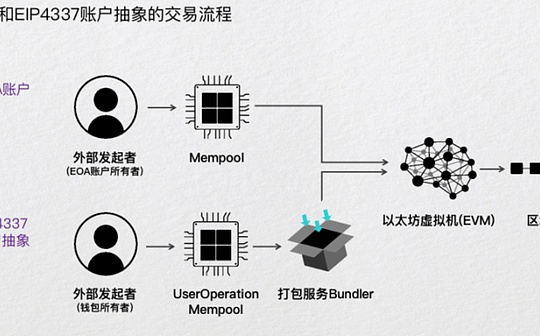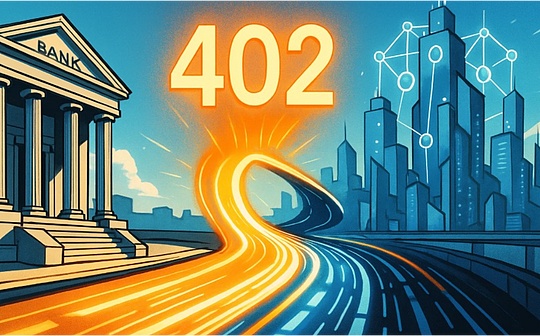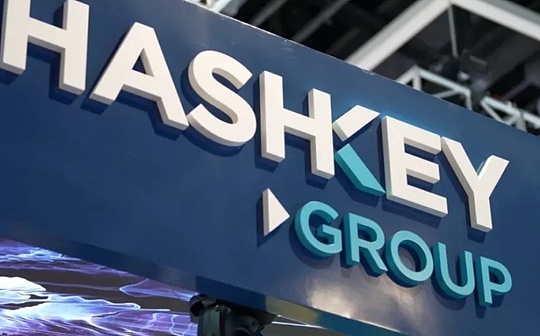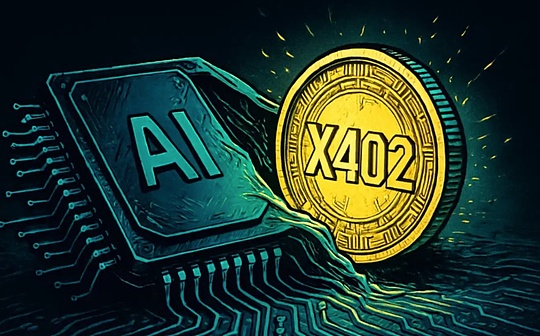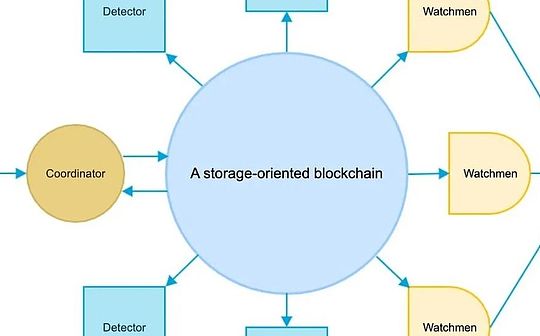
Source: Wuyue, Geek Web3
A public chain expansion scheme is conceived with the following characteristics:
-
It has a speed comparable to traditional Web2 applications or exchanges, far exceeding any public chain, L2, rollup, side chain, etc.
-
There is no Gas fee, and the cost of use is 0.
-
The funds are highly secure, far exceeding centralized facilities such as exchanges, and inferior to Rollup but equal to side chains.
-
The same user experience as Web2 does not require any understanding of the blockchain’s public and private keys, wallets, infrastructure, etc.
This solution is really exciting: on the one hand, it has basically achieved the ultimate in scaling; on the other hand, it has also laid a solid foundation in Web3’s mass adoption, basically eliminating the gap between Web2 and Web3 user experience.
However, at present we don’t seem to think of any solution that can be so complete, because there is indeed too little mainstream discussion and practice.This article will introduce this very excellent and advanced next-generation Web3 computing platform design paradigm – Storage-based Consensus Paradigm (SCP).
We used the issue of expansion as a very familiar topic above, but in fact, SCP andNot limited toExpand capacity use, its design inspiration does come from the expansion plans and community discussions of public chains such as Bitcoin and Ethereum.And its vision and practical application areBuild a new generation of computing platforms with public or non-blockchain structures.
SCP BasicsComponentsand working principle
-
Data availability layer:A widely recognized and proven public chain or permanent storage facility serves as the data availability layer, such as Ethereum, Arweave, etc.
-
Execution layer:A server is used to receive user transactions and execute them, and at the same time, the original transaction data signed by the user is submitted in batches to the DA layer, which has a high similarity to Rollup’s sorter.However, this execution layer does not necessarily need to have blockchain-related concepts such as blockchain data structure or EVM compatibility.It can also be a Web2 database + computing system, but the entire computing system must be open source.
-
Consensus confirmation layer:It consists of a group of nodes that pull the original data submitted by the execution layer to the DA layer, and calculate the data using the same algorithm as the execution layer to confirm whether the result output of the execution layer is correct, and can be used as disaster prevention for the execution layer.redundancy.Users can also return data from each node of the consensus confirmation layer to ensure that the execution layer is free of fraud.
-
Settlement layer:It consists of a group of nodes and contracts or addresses on other chains, which are used by users to recharge into SCP and withdraw cash to leave SCP.The node also needs to run the same algorithm as the execution layer and pull the data for verification.The node controls the withdrawal function of the recharge address through multiple contracts or TSS-based addresses.During recharge, the user recharges the specified address of the link, and sends a request to the execution layer when withdrawing. After the settlement layer node reads the data from the DA layer, it performs multiple signings or TSS releases the assets.The security level of the settlement layer is the same as the cross-chain mechanism of side chains or cross-chain bridges, and they also use the same or equivalent withdrawal settlement system.
everPay
EverPay is a pioneer of SCP and has taken the lead in building its own products based on SCP. At present, the main functions of everPay areRecharge, transfer, withdrawal, swap, on this basis, almost any Web3 and Web2 functions can be extended in the future.
Now we fully understand the storage consensus paradigm through everPay’s workflow.
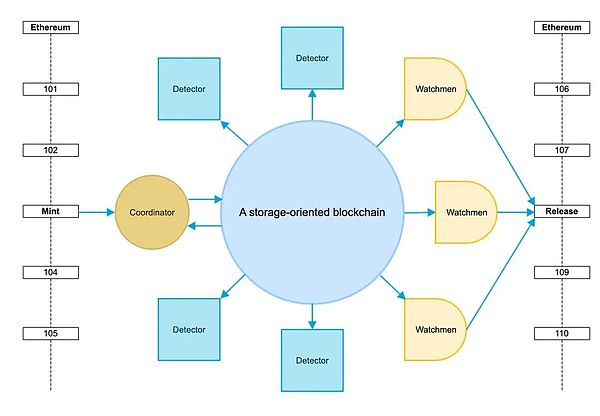
The DA layer of everPay uses the permanent storage facility Arweave, which is the large circle in the figure.
Coordinator, that is, the execution layer.The user submits the transaction to the coordinator, who performs the operation and presents the operation results, and then batches the user’s original input data to the DA layer.
Detector, pull the original transaction data submitted by the coordinator from Arweave, and use an algorithm consistent with the coordinator to verify the data and results.The detector’s client is also open source and can be run by anyone.
Watchmen, a group of detectors who are in charge of multiple signings in the withdrawal system.The withdrawal request will be verified and released based on the transaction data.In addition, the Watcher is also responsible for signing the proposal.
We can see that the consensus reached by the entire system is all located off-chain, which is the essence of the storage consensus paradigm – it abandons the consensus system between blockchain-based nodes, thus allowing the execution layer to get rid of the heavy consensus communicationAnd the confirmation process only requires the work of one server, so as to achieve almost unrestricted TPS and economicality.This is very similar to Rollup, but SCP can be said to have made the concept of Rollup more abstract and elevated, changing it from an extended use case to the design paradigm of the new generation of Web3 computing platform.
The coordinator of everPay is a server, but that doesn’t mean the coordinator can do whatever he wants.Similar to Rollup’s sorter, after the original data submitted by the user is submitted in batches on Arweave, anyone can run the detector program to verify it and compare it with the status returned by the coordinator.This is itself because the state transition function (STF) is a deterministic function, input —> STF —> output.As long as everyone’s STF is the same and the input is the same (all submitted to DA, cannot be tampered with and can be publicly visible), the output obtained must be the same.
Under this architecture, a centralized server and database does not pose a fundamental challenge.This is also another essence of the SCP paradigm, which binds and decouples the concepts of “centralization” and “single entity” – in a decentralized system, there can be completely centralized components, or evenA core component, but this does not affect overall decentralization.
From this we can shout a sensational but logical slogan – “The next generation of blockchain does not have to be a blockchain.”Because people’s original intention of inventing and using blockchain is to decentralize, consistent account books, non-forgery, traceability and other clichés, no matter whether it is the expansion plan of the old public chain or a brand new public chain, everyone has formed aA certain mindset: what we do must be a blockchain (composed of consensus communicated by nodes), or a Rollup solution that seems to be a chain (it only has a blockchain data structure, but no nodesexchange consensus).But now, even if the SCP-based solution is not a blockchain, it can meet a series of needs such as centralization, consistent ledgers, non-forgery, traceability, etc.
Execution layer
The execution layer is crucial in the entire system. It undertakes the throughput and operations of the entire system, and also determines what kind of applications can be run on the entire system.
Unlimited possible execution environments
Theoretically, the execution environment in the execution layer can be made into any form, and the possibilities are endless, depending on how the project party locates its own project:
-
Exchange.Based on SCP, an open, transparent, and unlimited TPS exchange can be built. The exchange can not only have the characteristics of CEX rapid and zero cost, but also maintain the decentralization of DEX.The difference between CEX and DEX becomes blurred here.
-
Payment network.Similar to Alipay, PayPal, etc.
-
Supports virtual machines/blockchain for loaders/contracts.Any developer can deploy any application on it, share all user’s data with other programs and operate according to user’s instructions.
Because users have completely got rid of the blockchain-shaped wallet and only interact with the server, their user experience is consistent with traditional Internet applications, but at the same time it is decentralized.
It can be seen that the above process already includes similar concepts such as cross-chain swap and account abstraction, and of course it is just similar. We only understand it in the context of SCP.Especially concepts like account abstraction are naturally unnecessary for SCP, which should be said to be a burden left by Ethereum.After many rounds of efforts, the Ethereum community finally launched the EIP-4337 standard to solve one of the problems of large-scale adoption of Web3 – the account problem.Moreover, EIP-4337 is just a standard, and its application practice remains to be tested.Under the SCP architecture, there is no concept of account abstraction – you can use Web2 standard accounts and blockchain accounts at will.From this perspective, many mature Web2 use cases can be directly used on SCP without rethinking and building.
Transparency and asymmetry
As mentioned above, sensitive readers should have discovered that although SCP can utilize the Web2 account system, it seems that there are problems with using it intact.
Because the entire system is completely transparent!Directly using the user’s interaction model to the server will cause serious problems, resulting in no security in the entire system.Let’s first review how the traditional server-user model works:
1. Account registration:Users enter their username and password on the application registration page.To protect the user’s password, the server will process the password through a hash function after receiving it.To increase the complexity of the hash and to resist rainbow table attacks, a randomly generated string (called “salt”) is usually connected to each user’s password and hashed it together.Usernames, salts, and hashes are stored in the service provider’s database in plain text and are not disclosed to the public.But even so, salting and safety treatment are needed, first to prevent internal ghosts and second to prevent attacks.

2. User login:Users enter their username and password on the login form.The system compares the processed password hash value with the hash value stored in the database.If the two hashes match, it means that the user has provided the correct password and the login process continues.
3. Operation certification:After the login verification is passed, the system will create a session for the user.Typically, session information is stored on the server and the server sends an identity (such as a cookie or token) to the user’s browser or application.Users no longer need to repeatedly enter their username and password in the next operation: the browser or application saves the identity and comes with the identity in each request.
Let’s review the typical Web3 blockchain-user interaction system:
1. Account registration:In fact, there is no account registration process, nor is there a username-password system.Account (address) does not require registration, it exists naturally, whoever controls the account with its private key.The private key is generated randomly locally by the wallet and does not involve networking.
2. User login:The use of blockchain does not require login. Most dApps do not have this process of logging in, but connect to the wallet.Some dApps will require users to sign and verify the identity of the connected wallet after connecting to the wallet to ensure that the user really holds the private key of the wallet, rather than just passing a wallet address to the front end.
3. Operation certification:The user directly submits the signed data to the node. After verification, the node will broadcast the transaction to the entire blockchain network. After satisfying the consensus of the blockchain network, the user’s operations will be confirmed.
The difference between the two modes is caused by symmetry and asymmetry.In the server-user architecture, both parties have the same secrets.In the blockchain-user architecture, only users have the secrets.Although the execution layer of SCP may not be a blockchain, all data needs to be synchronized to the publicly visible DA layer, so the login and operation verification methods used by SCP must be asymmetric.But because I don’t want to have cumbersome actions and poor experiences that affect large-scale adoption, such as allowing users to keep private keys, use wallets, etc., the application built on SCP has a strong need to use traditional ID passwords or OAuth three-party authentication login. So howWhat about combining the two?
Since asymmetric cryptography and zero-knowledge proof pairs are asymmetric, I envision two possible solutions:
-
If you want to use ID-cryptography, this password-storing module can be not made into SCP, so that other people will not see it.The SCP execution layer still uses the blockchain’s public-private key account and operation logic, without registration, no login, etc.The user’s ID will actually correspond to a private key.Of course, this private key cannot be stored on the project. A more feasible solution is to use 2-3 MPCs to solve the problem of centralized storage, while not allowing users to have the burden of using private keys.
-
When relying on OAuth login, JWT (Json Web Token) can be used as a way to authenticate.This method will appear slightly more central than the above, because it essentially needs to rely on third-party login services provided by major Web2 manufacturers as identity authentication.When logging in with a third party for the first time, the fields in the JWT that represent the user’s identity and the service provider’s identity are registered in the system.In the user’s subsequent operations, the operation instructions are used as public input, and the JWT as a secret witness is used to verify each user’s transaction.Each JWT has an expiration time limit, and the user will also apply for a new JWT the next time he logs in, so there is no need to keep it.In addition, this system also needs to rely on JWK, which can be understood here as the public key provided by a large manufacturer to verify JWK.So how JWK is decentralized to input into the system, and how to deal with private key rotation in the future, etc. are also worth discussing.
No matter which method is used, this is more expensive than traditional methods of development and computing, but it is also a necessary price for decentralization.Of course, if the project party does not think that achieving the ultimate decentralization is necessary, or there are different milestones at different stages of development, it is also possible to have these designs, because decentralization is not black or white, but existsGray area in the middle.
Privacy
The transparency issue mentioned above not only affects the user’s interaction paradigm, but also affects user data.User data is directly exposed.Although it is not a problem in blockchain, this is not very acceptable in some applications, so developers can also build a privacy transaction system.
TOLL
How the execution layer charges is another point worth paying attention to.Because submitting data to the DA layer also requires cost, including the operation of its own server.The first core purpose of traditional blockchain charging users a gas fee is to avoid users from swiping a large number of duplicate transactions to destroy the transaction network, and the second is to sort transactions based on gas.Web2 has no similar concerns, so there are only basic concepts such as flooding and DDoS.
The execution layer can customize various charging strategies, such as completely free or partial charging, or profit from other behaviors such as MEV (which is already very mature in the sorter), marketing activities, etc.
Resistance to censorship
The execution layer is not censor-resistant and can theoretically reject user transactions without restrictions.In Rollup, censorship resistance can be guaranteed by the mandatory collection function of the L1 contract, while side chains or public chains are complete distributed blockchain networks, which are difficult to review.
There is currently no clear plan to correct this problem, which is an issue in the SCP paradigm.
Consensus confirmation layer
This layer is composed of loose nodes that do not actively form any network, so it is not a consensus layer, but is only used to confirm the status of the current execution layer to the outside world (such as the user).For example, if you have doubts about the running status of everPay, you can download its detector client, which will run the same STF as the coordinator.
However, this is similar to Rollup. Since the data is submitted in batches, the status returned by the execution layer to the user is always newer than that on the DA layer.This involves a problem of finality of soft and hardness.The execution layer gives the user a soft finality because it has not been submitted to the DA layer yet; while the consensus confirmation layer provides the user a hard finality.Users may not be particularly concerned about this, but for applications such as cross-chain bridges, hard finality must be followed.For example, the exchange’s recharge and withdrawal system will not rely on the instantaneous finality of the Rollup sequencer.
In addition to being used to confirm the results, the consensus confirmation layer has another very important role, which is the disaster prevention redundancy of the execution layer.If the execution layer strikes permanently and commits serious evil, at this time, any consensus confirmation layer can theoretically take over the execution layer’s work and receive user requests.If such a serious situation occurs, the community should choose stable and reliable nodes as the servers for the execution layer.
Settlement layer
Since SCP is not a Rollup, it is impossible to achieve trustless withdrawals that do not require manual intervention and are entirely based on mathematical and smart contract codes like the Rollup withdrawal settlement layer.Its degree of security is the same as the cross-chain mechanism of side chains or cross-chain bridges, and requires the authorized observer to release assets. We call it the Witness model.

Decentralization of Witness Bridge as much as possible is a topic of many cross-chain bridge research.Due to space limitations, I won’t go into details here.A well-designed SCP platform must also have multi-signature partners with reputable decentralized bridges in practice. For example, everPay has conducted in-depth cooperation with MPC service provider Safeheron.
Someone might ask why SCP does not use a chain with a smart contract as the DA layer?This allows a settlement layer to be made that is completely trust-free.
In the long run, as long as some technical difficulties are overcome, if the DA layer is placed on the DA layer with contracts such as Ethereum and the corresponding contracts for verification can be built, SCP can also obtain the same settlement security as Rollup, andNo need to use multiple signs.
But in practice this may not be the best choice:
1. Ethereum is not specifically used for data storage, the price is too high compared to pure data storage public chains.For the SCP paradigm, a sufficiently low or fixed storage cost is crucial.
2. Prove that the system is very difficult to develop, because SCP can not only simulate EVM, but also implement any logic.If we look at the fact that teams like Optimism have not yet been launched, and the development difficulty of zkEVM, we can imagine that it is extremely difficult to implement various systems on Ethereum.
Another more important point is that the so-called settlement security as Rollup is only for the DA layer chain with smart contracts, such as Ethereum, because all the original data is passed to Ethereum.Then your settlement contract on Ethereum can “reference” the original input data to prove the correctness of the final state (note that it is not a direct reference but indirectly leaving the status mark of the original calldata through hash or accumulator, becauseThe calldata of historical transactions cannot be referenced by the contract itself).But for other chains, the same security cannot be enjoyed because they have no data on it.If you want to cross other chains, you can only use the Witness mode cross-chain bridge.
Therefore, the Rollup solution only has better settlement security from a specific perspective, that is, if you regard a chain as your parent chain.SCP is not a certain public chain expansion solution, but a larger Web3 computing platform architecture, so it does not have to be implemented from a certain chain-centric perspective.Building the settlement layer on a smart contract, except for the parent chain, it cannot guarantee the settlement security of other chains. If you don’t specifically expand the capacity of this chain, it will be completely unreasonable.
Summarize
One picture compares SCP with other paradigms.
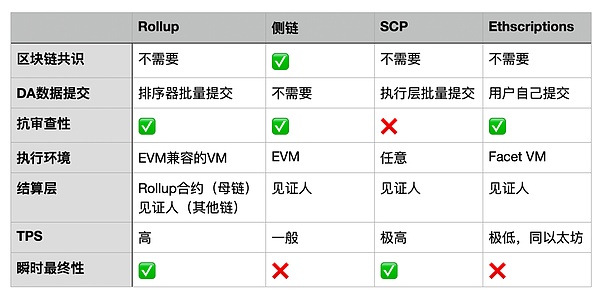
SCP is a brand new Web3 computing platform paradigm, comparable to the application speed of traditional Web2 transactions. The transaction cost can be negligible. Unlimited possible applications can be built on it, and the security is consistent with mainstream solutions.At present, a number of applications such as everPay, PermaSwap, Mind Network, etc. have emerged under the SCP paradigm. Based on their excellent design concepts, it is very hoped that this round and the next bull market will usher in explosive growth.


